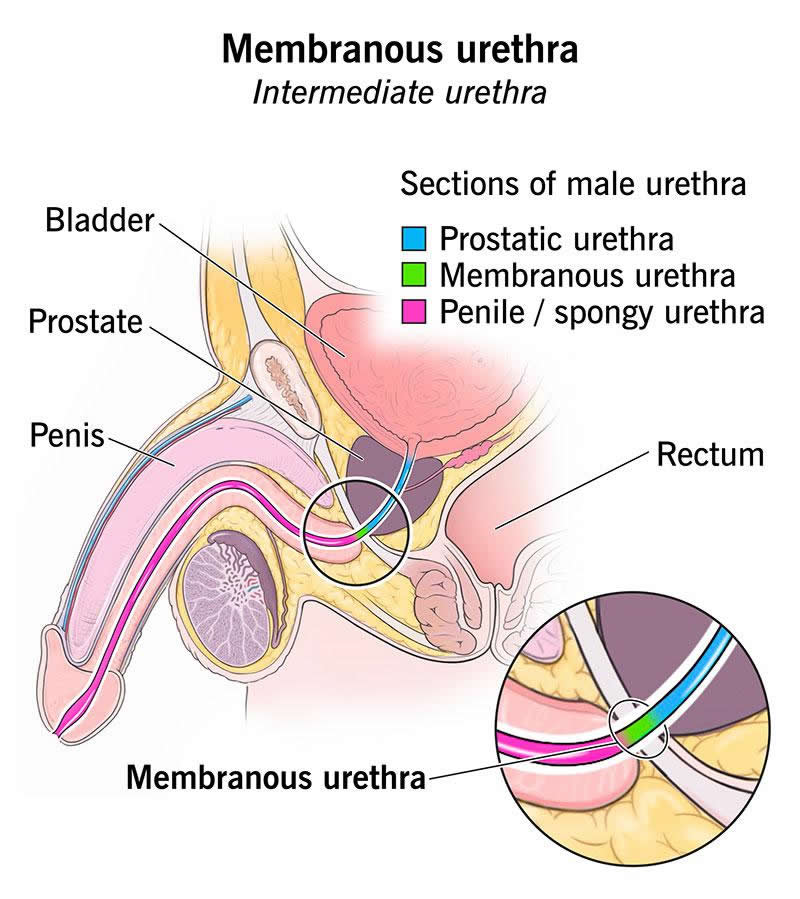Membranous Urethra
The membranous urethra is the shortest, middle section of the male urethra. Also known as the intermediate urethra, it ends right above your penis. This part of your urethra has muscular tissue around it, so it helps you hold in your pee. Blockages, inflammation, infection and cancer (rarely) can affect your membranous urethra.
Overview

What is the membranous urethra?
The membranous urethra is part of the male urethra. A female urethra doesn’t have one.
The urethra is a tube that empties urine (pee) from your bladder. In men, it also carries semen as part of the male reproductive system.
The urethra starts at the bottom of your bladder. It ends at the tip of your penis. The membranous part is in the middle. Another name for it is the intermediate urethra.
Function
What is the function of the membranous urethra?
The membranous urethra helps you hold urine in. Muscles surround this part of your urethra. They tighten when you need to hold pee. They relax when you’re ready to pee.
Anatomy
Where is your membranous urethra located?
It starts just below your prostate. Your membranous urethra passes through your pelvic floor and ends above the base of your penis at the perineum as it exits the pelvis. There, the membranous part of your urethra becomes your penile, or spongy, urethra. That extends down through the length of your penis.
What are the parts of a membranous urethra?
Your membranous urethra has three layers. They are the:
- Outer layer: Thick, elastic muscle fibers make up this layer. They help your membranous urethra contract and stay tight.
- Middle layer: This includes blood vessels, lymph vessels and some glands.
- Inner layer: This is epithelial tissue that protects your urethra from urine, semen and toxins.
What does it look like?
The whole urethra looks a bit like an “S” turned on its side. The membranous urethra is the first curve of the “S.”
The urethra is about 8 inches long in males. But the membranous part of it is only about half an inch long. It’s the shortest section.
Conditions and Disorders
What are the common conditions and disorders that affect it?
Some of the most common problems that affect your membranous urethra are:
- Urethral cancer: This usually starts in the cells of your urethra’s inner lining. This is a rare form of cancer.
- Urethral strictures: These are blockages or narrowing in your urethra. An injury, surgery or infection usually causes these. Often, providers don’t know what caused the stricture. These are called idiopathic.
- Nongonococcal urethritis (NGU): NGU is inflammation of your urethra. It can come from a viral or bacterial infection. Usually, sexually transmitted infections (STIs) cause it.
- Urinary tract infections (UTIs): A UTI is an infection in any part of your urinary system, like your urethra.
- Pelvic floor dysfunction: Some people have difficulty relaxing the muscles of their pelvic floor, including the muscles that surround the membranous urethra. This can happen to younger people and make it difficult to pee.
Signs/symptoms that something isn’t working right
You may not have any signs of a problem. Talk to your healthcare provider if you notice symptoms like:
- A need to pee more often and urgently than usual
- Bloody urine (hematuria) or semen (hematospermia)
- Burning sensation when you pee
- Difficulty peeing, needing to strain to push pee out
- Discolored or cloudy discharge from your urethra
- Dysuria (painful urination)
- Pain in your belly (abdominal pain)
- Pee leakage (urinary incontinence)
- Sore or swollen penis
Care
How can I take care of my membranous urethra?
You can care for your urethra in these ways:
- Avoid too much alcohol and caffeine.
- Don’t use tobacco products.
- Drink plenty of water and eat fiber-rich foods.
- Empty your bladder all the way.
- Pee after sex.
- Pee as often as you need to.
- Practice safe sex by using condoms.
- Stay active and maintain a body weight that’s healthy for you.
- Wear cotton underwear and avoid tight pants.
Additional Common Questions
What is the difference between membranous and spongy urethra?
The membranous part of your urethra is short. The spongy urethra is as long as your penis. The spongy urethra has some wide parts. The membranous urethra is narrow.
What causes membranous urethral injury?
A fall or a medical procedure can cause a membranous urethral injury. Examples include:
- Pelvic fracture
- Prostate surgery
- Kidney stone removal
- Traumatic Foley catheter insertion or removal
A note from Wockr
It’s frustrating to make more trips to the bathroom than usual. You rely on your membranous urethra to hold in your pee. But infections, injuries, swelling and other conditions can affect the health of your penis and urethra. Talk to your healthcare provider right away if you have any problems with peeing, like pain or blockages.